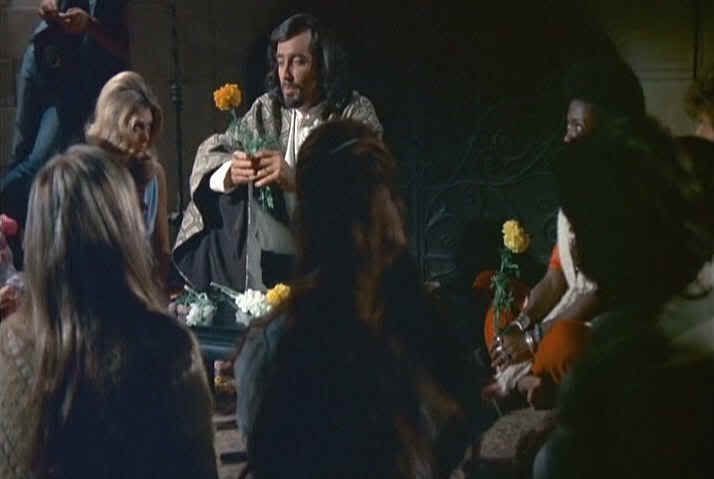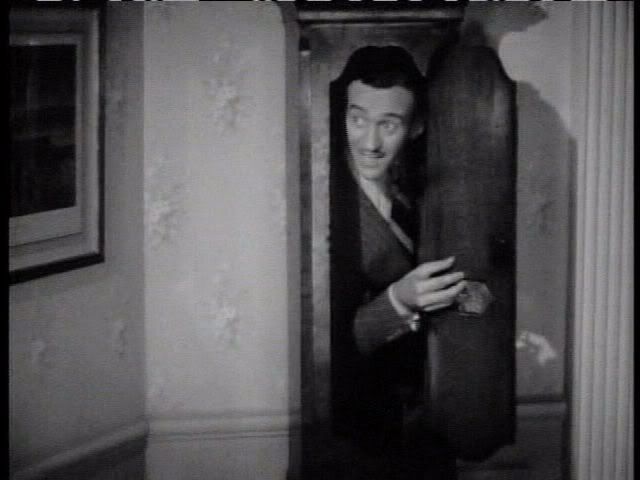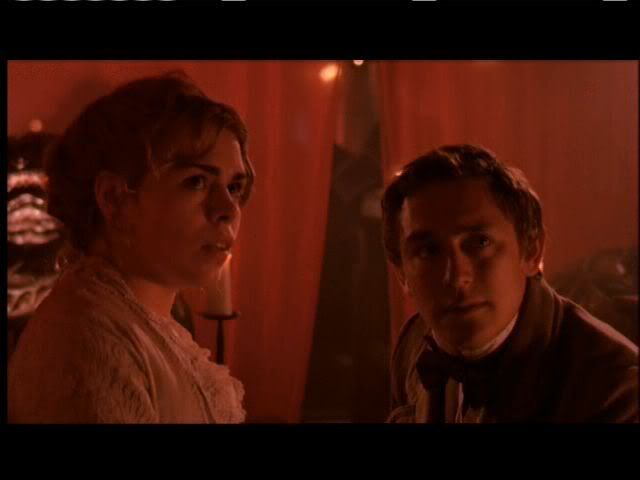Movie-a-Day, films 28-31
So, I've stopped using "weeks" in the title for these posts. I'm about 2 and a half weeks behind on blogging, and it's too much trouble to constantly go back and find out which week is which. At this point, I'm only 4 movies behind on viewing, (finished number 47 yesterday), so I really need to catch up on the reviews. Tomorrow is kind of busy, so I'll probably just do the first month's wrap-up post. Starting Monday, though I'm going to attempt two reviews a day until I get caught up within a week of my viewing. Fingers crossed.
Oddly, I cant find the danged screencaps from this set of titles, except for a really boring image from Raffles. So for this set only, no caps by me. Sorry.
And now, the reviews:




28: The Climax (1944,USA) D: George Waggner W:Curt Siodmak and Lynn Starling from the play by Edward Locke
It’s “Phantom of the Operetta!” Only with not so much phantom. Universal attempts to clone their success with Phantom of the Opera by using the same lead actress (Susanna Foster) in a vaguely similar plot. Obsessed doctor (Boris Karloff) had murdered the operetta diva who had been the object of his attentions when she threatened to leave him. Some years later, he hears an ingénue who sounds exactly like her. He doesn’t take it well. Under the guise of treatment, he hypnotizes the poor girl so she can’t perform. Yeah, as sinister plans go, that’s pretty weak. A thrill-less thriller and a mystery with no mystery at all (they tell us everything up front.) Lots of operetta, though, if that’s what you dig. Male lead Turhan Bey (The Mummy's Tomb, "Babylon 5"'s Emperor Turhan) looks good in a tux but doesn’t have much to do except act concerned. Sinister housekeeper Gale Sondergaard (Sherlock Holmes and the Spider Woman) is sinister - except she actually isn’t. In the end the villain starts his own conflagration accidentally. Meh. Director Waggner and writer Siodmak did a much better job on The Wolfman a few years earlier. (purchased DVD)
29: Deathmaster (1972,USA) D: Ray Danton W: R. L. Grove
A mysterious guru named Khorda (charismatic Robert Quarry from Count Yorga, Vampire) appears at a hippie commune/crash pad near Big Sur one night, and pretty much takes over the place in no time. Only dissatisfied "Billy Jack" type fighting hippie Pico is unsure about him, and when he learns that Khorda is actually a vampire, it's up to Pico and local bookstore owner/amateur occult expert Pop (John Fiedler, the voice of Piglet!!!) to try to save Picos girl from Khorda's clutches.
Deathmaster really isn't a very good movie, but I really enjoyed it anyway. There are several factors that cause this reaction and I'll try to sum them up quickly, or I'll never finish this post. Factor One is simple nostalgia. This is exactly the sort of low-budget early seventies horror flick that would show up on channel nine on Saturday nights back in New York when I was in my early teens. It was films like this (though I never saw Deathmaster at the time) that provided much of my early education in the genre. The similarity between early seventies low-budget horror movies can be partly chalked up to Factor Two, a sort of extra (accidental?) realism achieved by low budget films with competent technical crews. Due to the lack of funds, set construction and costuming are basically reduced to found scenery and the actors' own clothing (or second-hand clothes a few years out of date), rather than the elaborate fake environments or designer fashions of the big money productions. This is further amplified by the post-Easy Rider trends in Hollywood film-making towards naturalism (not exactly the same thing as realism, but it tries to feel like it at least.) Of course, none of this works if the film looks like crap, so the presence of talented technical artists like Director of Photography Bill Butler (who would shoot Jaws a few years later) is vital. Butler and director Danton make great use of the fact that Big Sur is a gorgeous and eerie place to begin with. The wordless opening scene of the film has a wonderful mood of mystery to it, to the extent that the first words of dialogue uttered in the following scene come as a disappointment. Honestly, the only flaw here is the script, which vacillates between cliche and nonsense. Fortunately, I am not averse to either cliche or nonsense if delivered in an entertaining manner, which brings, in combo with the look and feel of the film to Factor Three, which I call the "Nightmare Effect." This is a bit of personal film theory based partly on the book "nightmare Movies" by Kim Newman. The gist is: cliche and nonsense are not necessarily detrimental to the effectiveness of certain kinds of horror film. Sufficient levels of surrealism, either deliberate or accidental, can lend a film a dream-like quality, whether embodied in an off-kilter realism or a full-on expressionistic artifice (for the former, see Roger Corman's The Trip, even though it's not a horror film; and for the latter check out Dario Argento's Suspiria; for both at once, you can't beat Don Coscarelli's Phantasm.) Deathmaster manages to achieve this effect on a minor level, enough for me to coast happily through the implausible behavior of the characters and the contrived nature of the action in the latter half of the film. Throw in a bleak 1970s ending, and I finish the film in a warm glow, brain awash in cinematic comfort food. I think by now you know whether you'd enjoy this or not, or you've at least come to the realization of what a babbling crank I am. I don't care, I'll just be over here hanging with my pal Deathmaster. (DVD rental)
30: Raffles (1939,USA) D: Sam Wood W: John Van Druten and Sidney Howard, based on the novel "The Amateur Cracksman" by E. W. Hornung
Well-known cricketer A. J. Raffles (David Niven from The Pink Panther) moonlights, unbeknownst to his fiancée (Olivia DeHavilland the same year as Gone With the Wind!), as a burglar (strictly in an amateur capacity, of course.) He fully intends to retire to enjoy the married life, but he needs to pull one last job to help his old pal Bunny pay off some gambling debts. Now, if Raffles were played by Chow Yun Fat, this would trigger a series of double-crosses, chases and shootouts, causing feelings of excitement and tension in the audience. Sadly, no such feelings arise here, as Raffles amiably infiltrates a house party at a country manor, affably evades a determined Scotland yard inspector, and suavely deflects suspicion until the final reel, at which time the Production Code declares that he can’t just get away with robbery free and clear, thus ensuring a totally unsatisfactory ending. Have I mentioned lately how much I hate that there Production Code? Well, I hates it. Raffles is a remake of a 1930 film starring the ultra-smooth Ronald Colman, which was itself based on a stage play adapted from the novel, assembled from several linked short stories. All in all, far too polite to be much fun. (DVR)
31: Ruby In the Smoke (2006,UK) D: Brian Purcival W: Adrian Hodges, based on the novel by Philip Pullman
There are two basic kinds of mystery story: the type where the characters and the reader are given clues to understanding an occurrence or situation which is mysterious at the outset, but which the protagonists and/or readers may make sense of by the end; and the type in which people run around acting mysterious until some folks show up to explain things. This is a mystery of the second type. That’s assuming, of course, that it was intended to be a mystery. It’s possible that I merely assumed such because it’s a crime story set in Victorian England, in which young Sally Lockhart (Billie Piper of "Doctor Who") must discover the whereabouts of a secret treasure and learn the truth about her connection to it. In the meantime, the rather vicious Mrs. Holland (Oscar nominated and multi-BAFTA winning Julie Walters, Mrs. Weasly from the Harry Potter films) is also searching for the jewel, and isn’t hesitant about eliminating anyone in her way. The clichés on display include: stuffy old Victorian aunt; back-story involving British soldiers during the Sikh Mutiny; a riddle telling the location of the treasure; a character learning that her father is not her real father; gratuitous identical twins; an opium den with a pseudo-aphoristic Chinese proprietress; a bit of the old capture/rescue game; and a final villain who is Secretly Chinese (that last one is an oldie I thought had wheezed its last gasp back in the 1930s, yet here it is). This is rather facile stuff, introducing our heroine and her new pals, letting the villains do bad stuff, padding things out with recurring nightmare/memory scenes. The heroine is plucky in a distinctly non-Victorian way, plus - she’s Billie Piper! Not the very model of the Victorian middle class, surely? The story ends with at least one mystery unsolved, at least one villain on the loose, and our party of adventurers circle of friends/surrogate family firmly established, implicitly promising a never-ending series of novels to follow. (There's been one further TV film to follow, Shadow of the North; I'm not in a hurry for that one).
csue_n_moo had actually warned me away from this one. It's not that I didn't believe you guys about it being both anachronistic and not a very good mystery story, but I just wanted to get a look at future Doctor Who star Matt Smith in action; he gets as much screen time as anyone else but Piper or Walters (who is easily the best thing about the film, even if her character self-destructs at the end). (DVD rental)
csue_n_moo